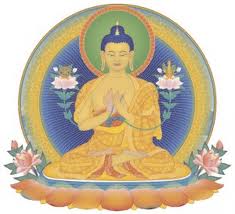The two truths of Nagarjuna
Ken sees nonduality as the integration of the absolute and relative realms. But it’s in how Ken frames the absolute and relative wherein I think Nagarjuna might differ. Ken sees the absolute causal realm as an ultimate and unchanging, whereas the relative realm is the realm of change and flux. Nagarjuna’s two truths doctrine though doesn’t seem to see it this way. For example the following excerpt shows their identity, not their distinction. Their distinction arises from a causal theory of a fixed nature which rectifies their dualistic differences. Nagarjuna clarifies how a fixed causal is erroneous within his notions of emptiness and dependent arising.
From the Internet Encyclopedia of Philosophy: http://www.iep.utm.edu/n/nagarjun.htmÂ
In his revolutionary tract of The Fundamental Verses on the Middle Way, Nagarjuna abjectly throws this elementary distinction between samsara and nirvana out the door, and does so in the very name of the Buddha. “There is not the slightest distinction,” he declares in the work, “between samsara and nirvana. The limit of the one is the limit of the other.” Now how can such a thing be posited, that is, the identity of samsara and nirvana, without totally undermining the theoretical basis and practical goals of Buddhism as such? For if there is no difference between the world of suffering and the attainment of peace, then what sort of work is a Buddhist to do as one who seeks to end suffering? Nagarjuna counters by reminding the Buddhist philosophers that, just as Gautama Sakyamuni had rejected both metaphysical and empirical substantialism through the teaching of “no-soul” (anatman) and causal interdependence (pratityasamputpada), so Scholastic Buddhism had to remain faithful to this non-substantialist stance through a rejection of the causal theories which necessitated notions of fixed nature (svabhava), theories which metaphysically reified the difference between samsara and nirvana. This later rejection could be based on Nagarjuna’s newly coined notion of the “emptiness,” “zeroness” or “voidness” (sunyata) of all things.”Â
Another article also explores these 3 elements in Nagarjuna and how they relate. Here the two truths doctrine is not about an ultimate, unchanging and absolute truth in distinction to a changing relative realm. The “higher” truth is again about the reification of an ultimate essense, as in a “causal realm” formulation. Thus the nondual of Nagarjuna is not about integrating an ultimate with a relative but about undoing an ultimate in the first place. In Ken’s terms it is postmetaphysical in undermining the metaphysical assumption of an ultimate. And Ken is still making such assumptions with his intepretation of an unchanging causal realm.Â
From “The Zen Teachings of Nagarjuna” by Vladimir K. at http://www.thezensite.com/zen%20essays/zenteachingsofnagarjuna.pdfÂ
The two truths doctrine is based on the view that there are two realities: conventional reality and the truth about this reality (a lower truth), and ultimate reality and its truth (a higher truth). In the final analysis, however, Nagarjuna rejects this duality and teaches that both realities are one and the same. It is our so-called ˜common sense™ understanding of the world that causes the problem because we tend to see the world as a collection of discrete entities interacting with each other and with the self. In the Buddhist view, this is called ignorance and leads to suffering (dukha). The two truths doctrine is based on the practicality of teaching (upaya) rather than dogma. From a conventional viewpoint, we can say that things are causally produced and are impermanent but from a higher viewpoint, causal production and impermanence (or permanence) cannot be established and dualistic thinking must be rejected. (Cheng, 1991:45)
Ultimate truth for Nagarjuna is the truth of an enlightened clarity which does not mistake the conventional for something essential (reification). This is where emptiness comes in as Nagarjuna teaches that all things are empty and the understanding of this emptiness leads to a greater truth of the way things really are. Of course, fundamentally, there is no real difference between the two realities as this truth of the highest meaning posits that œindividual existence cannot be grounded outside the context of everyday experience,(Huntington, 1989:48) thereby linking the two realities into one. In other words, a ˜higher truth is based only on conventional reality, not on a metaphysics.

